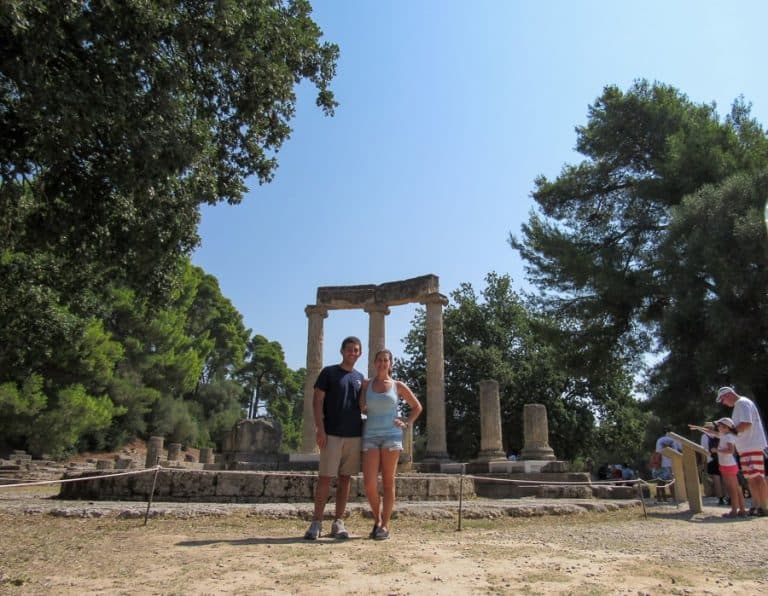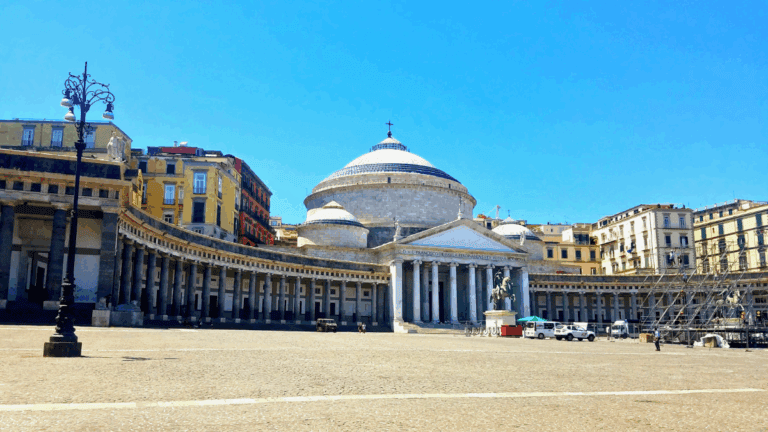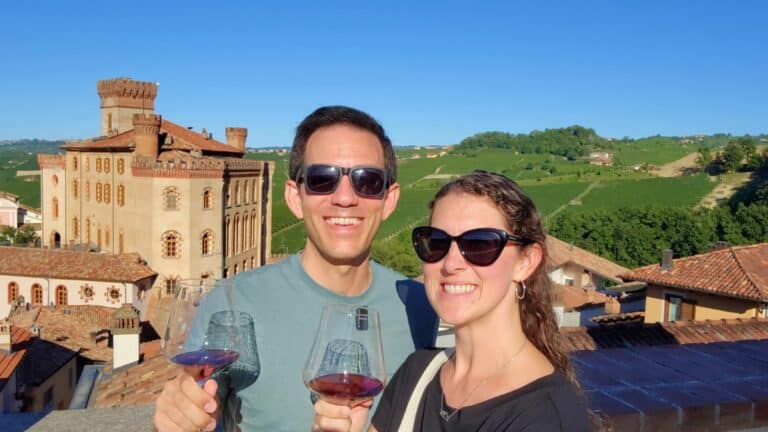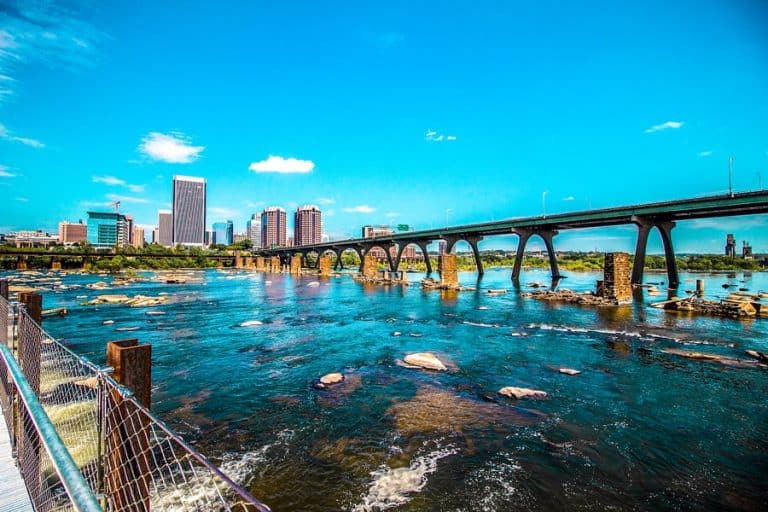3 Days in Rome Itinerary: The Perfect First-Time Guide
Planning your first trip to Rome and wondering how to spend 3 days in the Eternal City? This 3 days in Rome itinerary covers all the must-see landmarks, incredible food spots, and a few local favorites so you can make the most of your time.
When we first visited Italy, we weren’t sure how many days to spend in Rome – but after exploring the city’s top attractions, we found that 3 days in Rome is the sweet spot. You’ll see the highlights without feeling rushed and still have time to soak in the atmosphere that makes Rome unforgettable.
Of course, you could live in Rome for a year and still find new corners to discover. But if you’re short on time, this itinerary gives you the perfect mix of iconic sights, delicious bites, and authentic experiences.
Short on Time? Here are the key takeaways:
- Top sights: We’ve divided the best attractions into 3 easy-to-follow days.
- Where to stay: The Monti neighborhood or Centro Storico are ideal for first-time visitors.
- Favorite views: Don’t miss the rooftop at Vittorio Emanuele II and the Colosseum.
- Best experience: Take an Italian cooking class – it’s pure magic.
This post was originally published in November 2019, and was updated in October 2025.
**Boozing Abroad contains affiliate links throughout the site. If you choose to purchase items through these links, we will earn a small commission at NO extra cost to you. Read the full disclosure policy here**
Is 3 days enough for Rome?
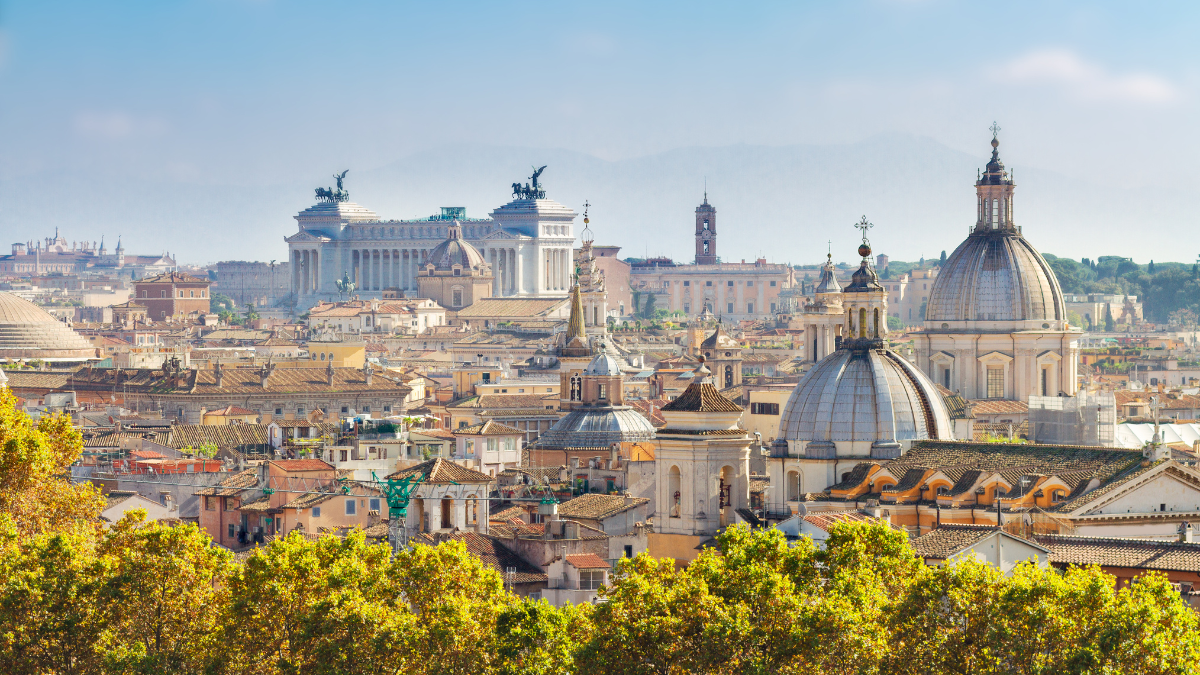
Yes – but you’ll be on the move. Rome is massive, layered in history, and bursting with landmarks, food, and gelato stops. Three days is doable, but you’ll need to plan your itinerary strategically to see the highlights without feeling rushed.
If it’s your first visit, 3 days in Rome gives you enough time to explore the major sights – like the Colosseum, Vatican, and Trevi Fountain – while still leaving space for a long lunch and a spritz (or two).
How to Get from Rome Airport to the City Centre
Most international flights land at Leonardo da Vinci–Fiumicino Airport (FCO), which is about 30 km (18 miles) from central Rome. Luckily, getting from Rome airport to the city centre is straightforward – you’ve got three solid options: train, taxi, or Uber.
Rome Airport To City By Train
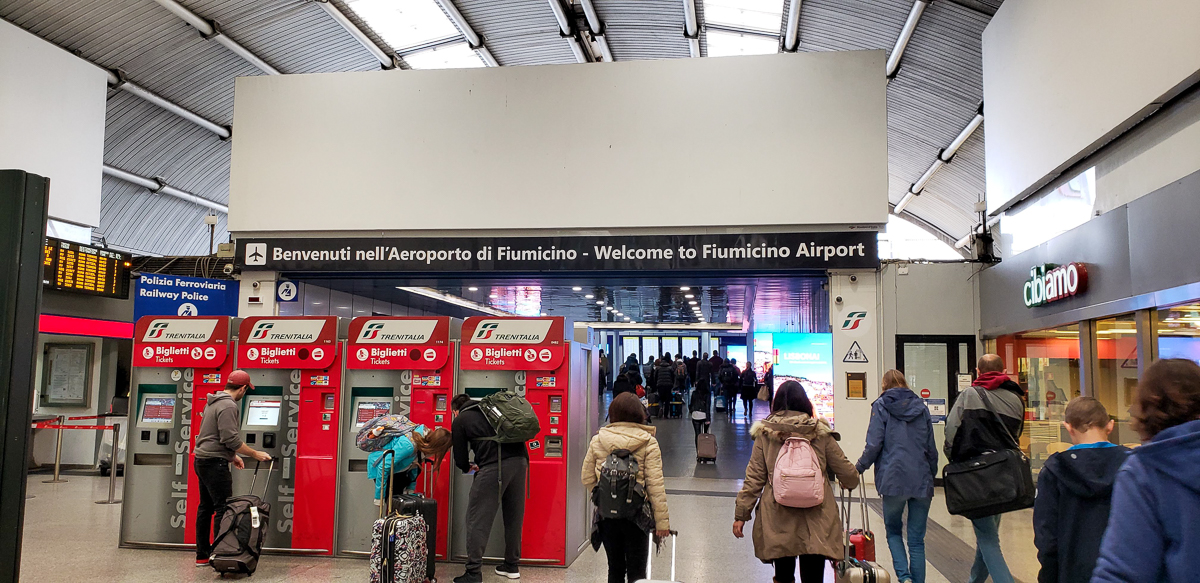
- Cost: Leonardo Express: €17.90 one-way; €35 round-trip
In our opinion, the Leonardo Express is hands-down the easiest and fastest way to get from Rome airport to Termini Station, the city’s main transport hub. It’s a direct, non-stop train that runs about every 15–30 minutes and takes roughly 30 minutes.
Where to find it: Just outside of baggage claim, follow the blue “Trains” signs toward Stazione Ferroviaria, near the Hilton Airport Hotel.
Once at Termini, you can hop on the local metro trains to reach your hotel or other neighborhoods in Rome.
Pro Tip: If you miss your scheduled train, don’t stress – tickets are flexible. Just chat with a Trenitalia staff member and they’ll usually let you board the next one.
If you are heading to the airport from the city, your Leonardo Express train will depart from either platform 23 or 24, which is on the far right side of Termini.
You can purchase your tickets online or at one of the ticket kiosks at Termini. If your schedule changes and you can’t make your original departure time, check with one of the customer service people to see if you can get on a different train (it usually isn’t a problem).
>>Traveling to Florence too? Check out our How to do Florence in 3 days guide <<
Rome airport to city by taxi
- Cost: €48
Official white taxis offer a fixed fare from FCO to central Rome, and the ride takes about 45 minutes (longer during rush hour).
A few things to note:
- Keep a few euros handy for tips or small purchases when you arrive.
- Taxis should accept cards, but some claim their machine “isn’t working.” Ask before getting in.
- Only use official white taxis from the designated taxi stand outside baggage claim. Ignore anyone offering you a ride inside – that’s almost always a scam.
Rome airport to city by Uber
- Cost: $70-90+
Yes, Uber works in Rome, though fares can be pricier than taxis or trains. When we checked, a ride from FCO to Termini averages around $75 USD, depending on time of day and surge pricing.
If you’re traveling with heavy luggage or late at night, Uber can be convenient – but for most travelers, the Leonardo Express is still the best balance of cost, speed, and simplicity.
Where to stay in Rome
One of the most important parts of planning your trip to the Eternal City is deciding where to stay in Rome. The city is big – and while public transportation is solid, we usually prefer to walk so we can wander down cobblestone alleys, stumble on hidden piazzas, and stop for an espresso (or spritz) whenever the mood strikes.
If you’re visiting for a short time, location matters. Here are our favorite neighborhoods for a 3-day stay in Rome that balance convenience, charm, and local vibes.
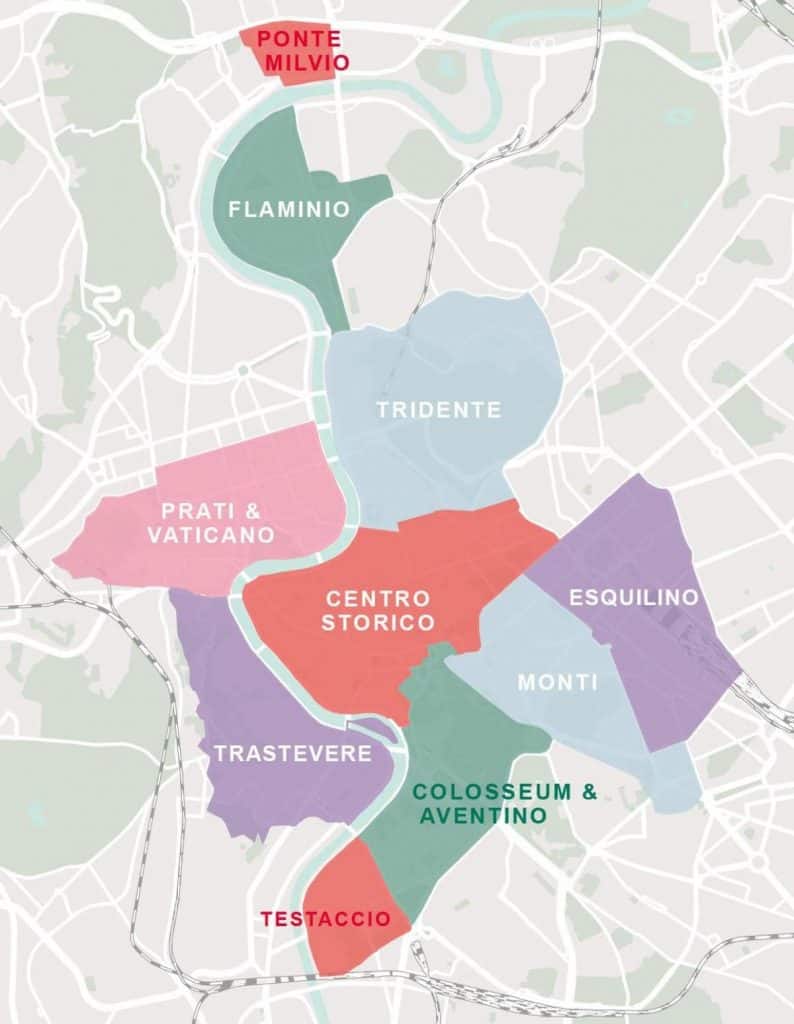
Monti Neighborhood – Central, Cool, and Close to Everything
Monti was our home base during our first visit, and we loved it. Just one quick metro stop from Termini (hop off at Cavour station), this neighborhood has that perfect mix of ancient history and modern cool.
We stayed in an Airbnb about five minutes from the Colosseum, ten from the Trevi Fountain, and fifteen from the Spanish Steps – you really can’t beat that for sightseeing.
Monti also comes alive at night. There are cozy wine bars, local trattorias, and a small market where we stocked up on cheap wine and cheese for pre-dinner aperitivo (10/10 recommend).
Why stay here: Walkable to major attractions, great nightlife, local charm without tourist chaos.
2 – Centro Storico
If you want to step outside your door and be surrounded by iconic landmarks, Centro Storico is your spot. This is Rome’s historic center, packed with postcard-perfect piazzas, gelato shops, and some of the city’s most famous sights.
On our second visit, we stayed at Unico Argentina Suites., just minutes from the Pantheon, Piazza Navona, and Trevi Fountain. You can easily check off half your 3 days in Rome itinerary within walking distance.
From Termini, take Metro Line A to Barberini – Fontana di Trevi (two stops), and you’re right in the middle of the action – the station name says it all.
Why stay here: Super central, historic charm, perfect for first-timers who want to walk everywhere.
Find the Perfect Hotel in Rome
If you already know your travel dates, use the search box below to find the best hotels in Rome. From boutique stays in Monti to elegant hotels near the Trevi Fountain, Booking.com has hundreds of options across every budget.
Pro Tip: Staying central saves you time (and sanity) when exploring Rome’s top attractions. If it’s your first visit, you can’t go wrong booking something in Monti or Centro Storico.
How to plan 3 days in Rome?
The best way to tackle 3 days in Rome is by grouping attractions by location. Our itinerary breaks down what to see, where to eat, and which spots to hit each day. Everything is planned so nearby sights are together, helping you maximize your time without running around like a caffeinated tourist.
Interactive Rome Map
Click the interactive map below to get a visual of your 3 days in Rome itinerary – it shows all the landmarks, restaurants, and hidden gems we cover in this guide.
HOW TO USE THIS MAP: To view the layers and see the names of the places on this map, click the tab in the top left corner. You can select the check marks to show or hide certain layers. If you select the icons on the map, you will get more information about the point of interest.
HOW TO SAVE THIS MAP: If you select the star icon next to the map name, you can save this map to your Google Maps account. To view it, open Google Maps in desktop or on your phone, select the menu button, go to “Your Places,” scroll to the right to Maps, and you will see this map.
3 days in Rome Itinerary

For this guide, we’ll assume you have 3 full days in Rome, arriving the night before and leaving on the evening of Day 3.
Pro Tip: All the fountains in Rome are drinkable. Bring a refillable water bottle and top up from any fountain to save money. And while we wait for the day when beer or wine fountains appear, a gelato nearby works just fine.
Day 1: Classic Spots in Rome
- Roman Colosseum
- Roman Forum
- Palatine Hill
- Lunch
- Vittorio Emanuele Monument
- Rome Walking Tour or Pasta tour
- Hostaria da Nerone
Roman Colosseum (Colosseo)

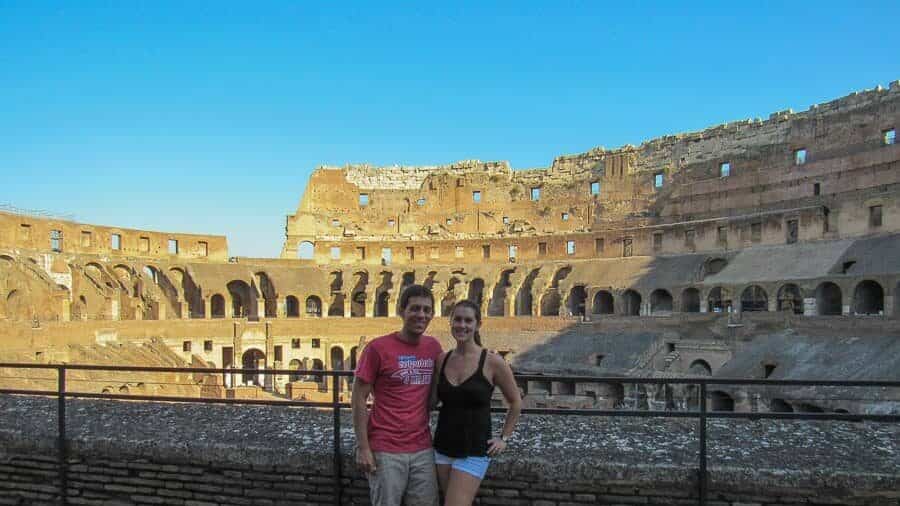
- Cost: €18 for the combo ticket (includes entry to the Colosseum, Roman Forum, and Palatine Hill)
- Hours: 8:30 AM until one hour before sunset
- Getting There: Metro Line B to “Colosseo” stop (2 stops south of Termini)
The Colosseum is one of the top attractions in Rome, and the lines can be long. We recommend either buying tickets online in advance or picking them up at the Palatine Hill entrance the night before – much less crowded.
We were at the Colosseum and the Forum by 7:45 a.m. and were some of the first people in line. After patiently waiting, the gates opened and we ran up to the top of the Colosseum. We’d highly recommend to anyone visiting to go early (prior to opening) and wait to get in.
We ran up to the top of the Colosseum (as far as we were allowed to go) and were able to take some fantastic photos – it looks like we have the place to ourselves! Just outside of the Colosseum, you’ll find the Roman Forum about a 5-minute walk across the street and up the hill.
Why consider a guided tour:
- Skip-the-line tours save time, especially if you want to fit in more Rome sights on Day 1.
- A guide can share stories and details that bring the Colosseum’s history to life.
- Audio or in-person tours give flexibility if you prefer to move at your own pace.
Recommended Viator options:
Pro tip: We personally used Rick Steves’ free audio tour, which works if you like exploring at your own pace. Plan for at least one hour here.

Fast Facts about the Colosseum:
- The Colosseum was built during 70-80 AD during the rule of Emperor Titus.
- More than 50,000 people watched exhibits of exotic animals, executions, and most notoriously, gladiator fights.
- In 2007, the Colosseum became one of the Seven Wonders of the Modern World and is visited each year by over 6 million people.
Roman Forum

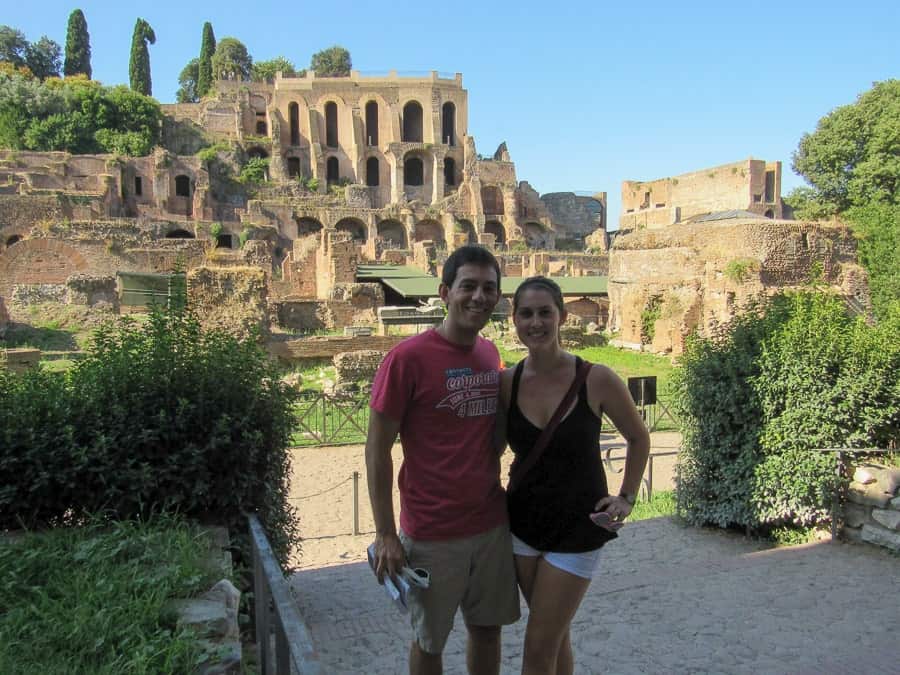
- Cost: €18 – Same combo ticket and times as Colosseum
- Hours: 8:30 AM until one hour before sunset
- Getting There: 5-minute walk from the Colosseum; Metro Line B to “Colosseo” stop (2 stops south of Termini)
The Roman Forum was the hub of ancient Rome, housing political, religious, and commercial activities dating back to 500 BC. Allow around 1.5 hours to walk and explore.
Why take a guided tour:
- Audio tours like Rick Steves’ free app give flexibility for independent exploration.
- Tours help you make sense of the sprawling ruins and identify what’s what.
- Guides highlight hidden gems and fascinating stories that you might miss on your own.
Recommended Viator options:
- Roman Forum & Palatine Hill Guided Tour – Focused historical insights from an expert guide.
- Rome: Colosseum Guided Tour with Roman Forum and Palatine hill – Great combo for all three sites.
Fast Facts about the Roman Forum:
- When the Roman Empire collapsed in the 3rd century, the area was reduced to a field for grazing animals. Becoming overgrown and neglected, it took more than 100 years to excavate the ruins with initial efforts beginning in the early 1800s.
- Julius Caesar’s body was burned in the Roman Forum after his assassination in 44 B.C. There is a temple in the Forum that was constructed in his honor.
The Roman Forum will lead you directly into Palatine Hill from the Arch of Titus.
Palatine Hill
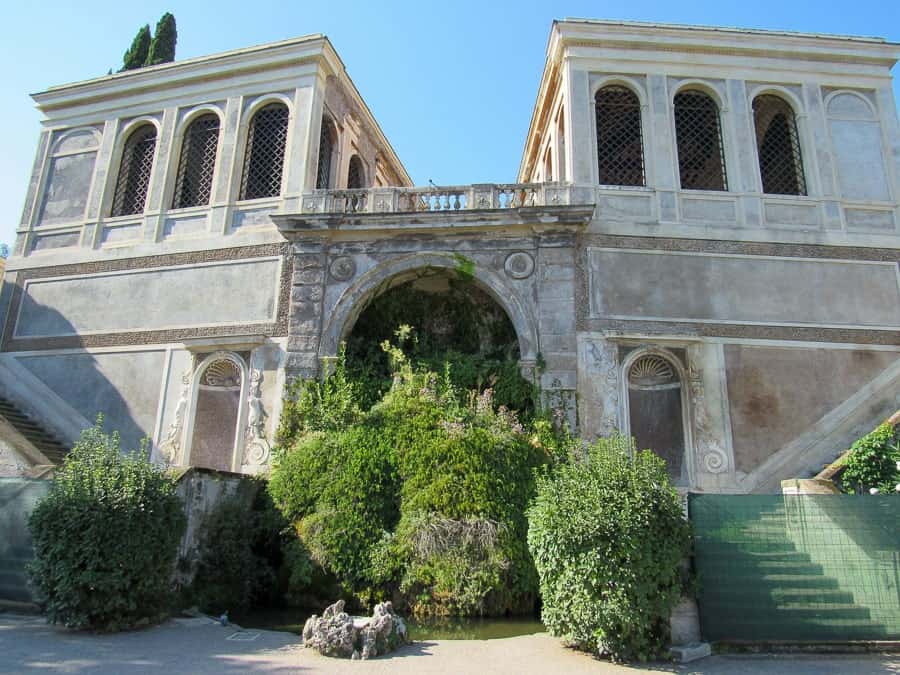
- Cost: Same combo ticket above
- Hours: 8:30 AM until one hour before sunset
- Getting There: Metro Line B to “Colosseo” stop (2 stops south of Termini)
Palatine Hill is the birthplace of Rome and offers stunning panoramic views. Allow 1.5 hours to explore, including the Farnese family’s Renaissance gardens.
In case you didn’t get the memo, free audio tour via Rick Steves. Just do it. The Palatine Hill will take you about 1.5 hours to explore and do the tour. The best view is through the Renaissance gardens of the Farnese family.
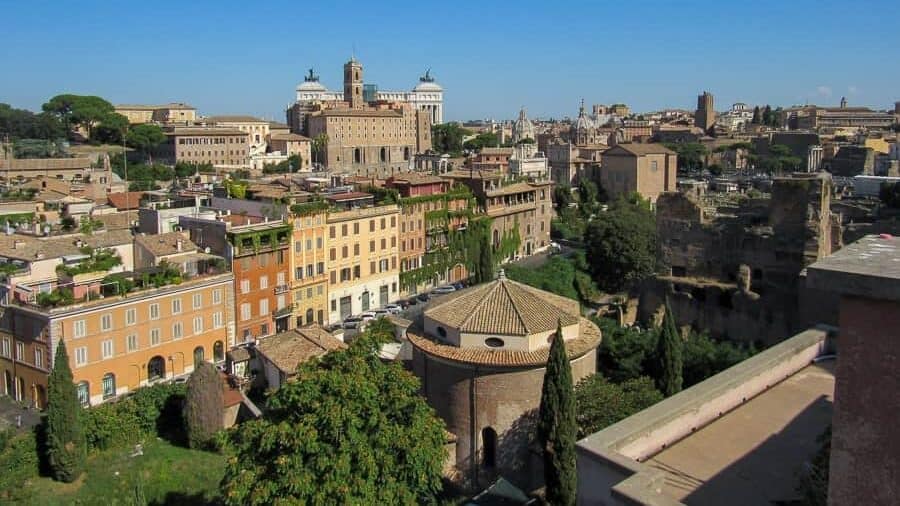
Fast Facts about Palatine Hill (and naming of Rome):
- According to Roman legends, there was a cave located in the Palatine Hill that was inhabited by a she-wolf, that took care of Romulus and Remus. According to the myth, when the brothers grew up, they decided to form a city on the banks of the river. But like all brothers do, they disagreed about certain things, so Romulus killed Remus (not something brothers do) and founded the city of Rome.
Lunch at Enotecca Cavour 313
- Hours:
- Tuesday – Saturday: 12 PM – 3 PM; 6 PM – 11 PM
- Sunday & Monday: Closed
After walking around the Colosseum, Roman Forum, and Palatine Hill, we were officially hangry. About a 10-minute walk from the Arch of Titus, we stumbled on Enoteca Cavour 313, a wine bar dedicated to helping you discover good food and wine. Amen!
Founded in 1935, it’s the perfect spot to kick back and refuel after a morning of exploring. We grabbed a small charcuterie board, sipped some local wine, and let our feet relax for a few minutes.
Vittorio Emanuele II Monument
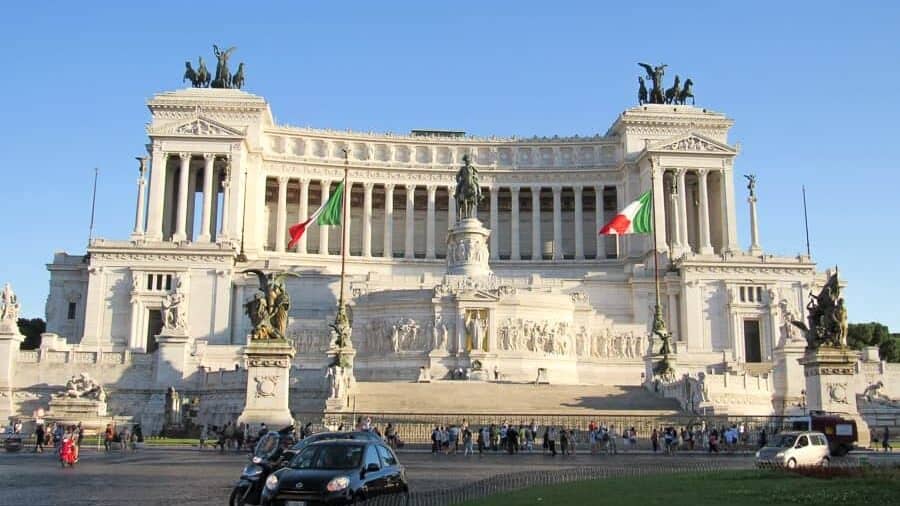
- Cost: €18 which includes the elevator to the top. Free to climb the steps to the first few levels
- Hours: 9:30 AM – 7:30 PM (last admission at 6:45 PM); closed on Christmas Day and New Years Day
- Getting There: Metro Line B to “Colosseo” stop (2 stops south of Termini)
After lunch, we walked about 10 minutes to Piazza Venezia to see the striking Vittorio Emanuele II Monument – the massive white marble building is impossible to miss. Compared to the earth-toned colors of much of Rome, this monument is a great landmark if you ever lose your way.
Finished in 1911 (in Roman terms, that’s like yesterday), this is one of the newest buildings in Rome and was built to commemorate the first king of Italy, Vittorio Emanuele II, who played a major role in the unification of Italy in 1870.
What to do here:
- Climb the first steps for a quick view – This is free and gives you a good perspective on the monument’s size.
- Check out the Altar of the Fatherland – Spot the soldiers guarding the Tomb of the Unknown Soldier and take a moment to appreciate the history.
- Stop at the café on the left-hand side – We grabbed a coffee (and yes, a glass of wine) while enjoying a view of the Colosseum. Perfect for a little rest before heading to the top.
- Take the elevator to the top (€18) – The panoramic views of Rome are fantastic. Maps help you identify landmarks across the city, and it’s amazing to see how sprawling Rome really is.
Pro tip: Even if you’re not into heights, walking a few steps up before the elevator is a great way to orient yourself in the city and take some memorable photos.
Evening Options After Day 1 in Rome
After a long afternoon exploring the Colosseum, Roman Forum, and Palatine Hill, it’s time to unwind and enjoy the evening.
Depending on your energy level and interests, here are some great options:
Option 1: Rome Walking Tour
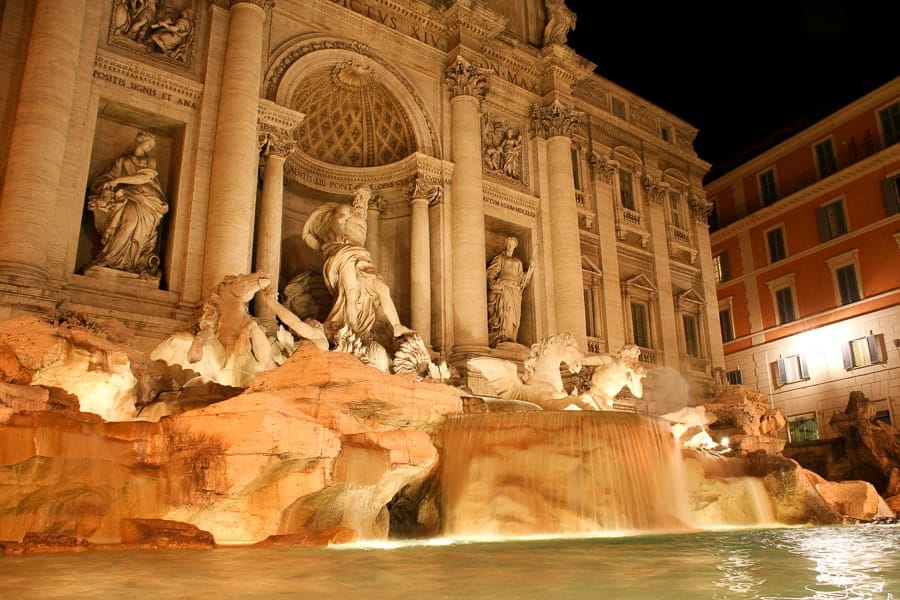
- Cost: €89 per person
- Time: 2.5 hours
- Start time: 6 PM
We booked the Rome Evening Stroll Walking Tour through What a Life Tours and we weren’t disappointed! In 2.5 hours, we wandered past Michelangelo’s apartment, a noble family residence, private churches, the Trevi Fountain, Egyptian statues, Parliament, the Pantheon, Piazza Navona, Campo de’ Fiori, and more.
To clarify, we didn’t go in any of these places, but got up close and personal with the historic buildings and heard the fascinating history behind them. We carved out additional time for heading inside the Pantheon and milling around Piazza Navona, among other things, on a different day.
The best part of the tour in Chris’s opinion was being treated to authentic gelato at a 100-year old business.
PRO TIP: You can recognize authentic gelato just by looking at. Steer clear of the places with super bright colors (usually means artificial colorings and flavors) and the perfect looking mounds of gelato (look for the big cylinders of the creamy goodness).
Why we love guided tours:
- Our guide shared stories we’d never have known otherwise
- Efficient way to see a lot without feeling rushed
- Insider tips, like the best gelato spots
While this tour has increased in price since we did it, we did find a similar tour on Viator at a much more affordable price.
Option 2: Pasta Making Class
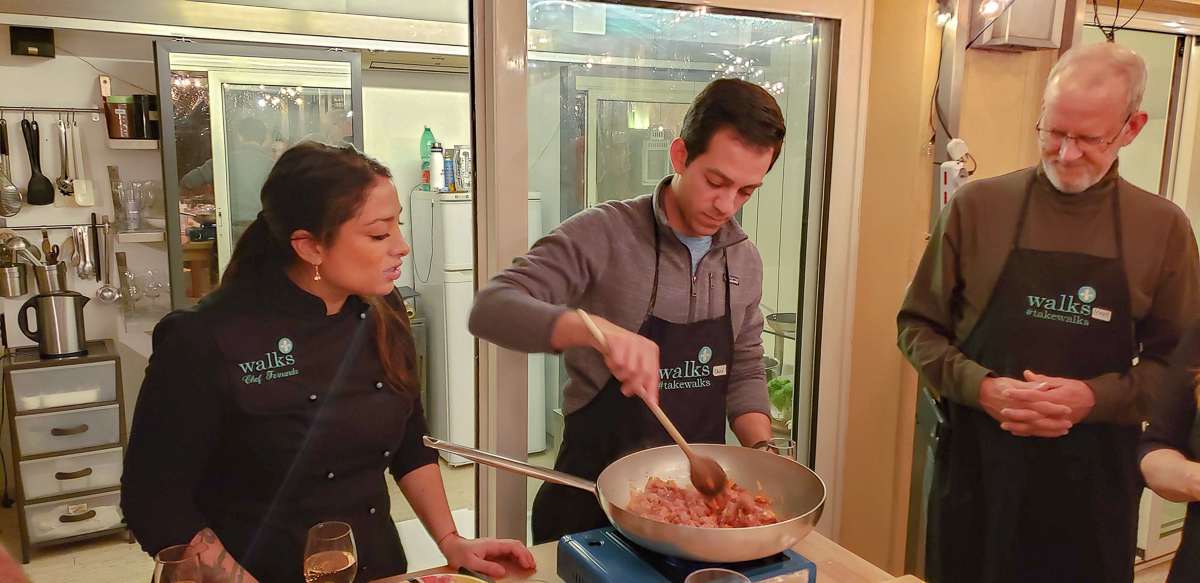
- Cost and Hours: €70+ per person | 3 hours
We’ve done several different tours in Italy and we absolutely loved our Pasta-Making class through Walks. This class is roughly 3 hours and includes hands-on training from true Italian chefs on how to make pasta from scratch.
On arrival, you’ll be greeted with prosecco and aperitivi, then move on to the pasta-making (which you get to eat at the end). After you’ve devoured your incredible pasta creation, to go along with healthy portions of wine, you’ll get to cap the night with gelato.
Depending on what you’re up for, this option wouldn’t let you explore the city like a normal walking tour, BUT you get to eat homemade pasta in Italy. The choice is yours.
If you’re looking for cheaper options, Viator has a variety of pasta-making classes that can be booked online in advance. You can filter by price, length, or even group size to find the perfect fit for your evening.
Option 3: Self-Guided Walk
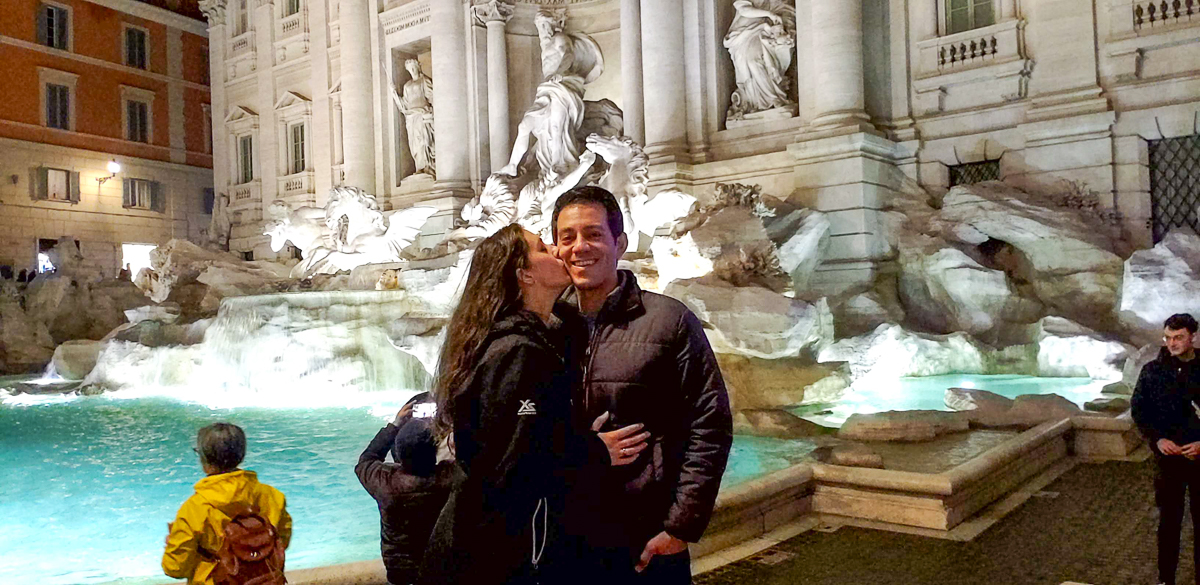
If you are looking to save money or are just too pooped to consider doing a tour/class, you can walk around the city at night to explore some of the most iconic attractions.
First up, you need to go to the Trevi Fountain. We didn’t include this in the day 1 portion since it’s on the walking tour.
We’ve done the Trevi Fountain both during the day and at night and it’s quite a different experience. The fountain is tucked away in an alley and HUNDREDS of people are trying to get close to it during the day for photos and to toss in a coin. At night, the crowds thin out and it’s much easier to get closer without being bumped by people trying to get the best photo for the ‘Gram.
We also personally think the way the fountain is lit at night makes it more magical. You won’t be sorry either way as it’s an incredible sight to see on your 3 days in Rome itinerary.
Another great option for day 1 in Rome is Piazza Venezia. You can slide this in after Vittorio Emanuele or on the way to or from the Trevi Fountain. Drinking in the streets is legal and many restaurants that line the plaza will sell food and wine. If you are looking for a low-key option, this is always a great choice. People watching is the best here too!
Dinner at Il Salotto del Colosseo
- Hours:
- Monday – Saturday: 12 PM – 3 PM & 7 – 11 PM
- Sunday: Closed
If you’re looking for a cozy, well-rated dinner option near the Colosseum, Il Salotto del Colosseo is a great choice. This family-run restaurant serves traditional Roman dishes with a modern twist, making it ideal for travelers who want authentic flavors without straying far from central Rome.
Day 2: Vatican City & Central Rome
- Vatican City
- Vatican Museum – Sistine Chapel
- St. Peter’s Cathedral aka “the dome”
- Spanish Steps
- Villa Borghese
- Piazza Navona
Italian Breakfast: Quick, Sweet, and Energizing
Mornings in Italy are a delightful ritual. As residents of Italy, we’ve embraced the local breakfast tradition: a quick espresso or cappuccino paired with a sweet pastry, typically a cornetto (Italian croissant) filled with jam, cream, or chocolate.
It’s a light and energizing start to the day, often enjoyed standing at the bar. Pick a cafe and enjoy a quick breakfast before heading out!
Pro Tip: There is sometimes a service charge for sitting so we always stand when we grab breakfast.
Getting to Vatican City
From Termini Station, hop on Metro Line A (red line) and alight at Ottaviano – San Pietro (6 stops). From there, it’s a short 5-minute walk to St. Peter’s Square, the grand entrance to the Vatican.
The Vatican became the religious and political center of the Catholic Church after Rome’s fall in the 3rd century. Over time, it has preserved Rome’s history, from ancient sculptures to Renaissance masterpieces.
Vatican Museums & Sistine Chapel
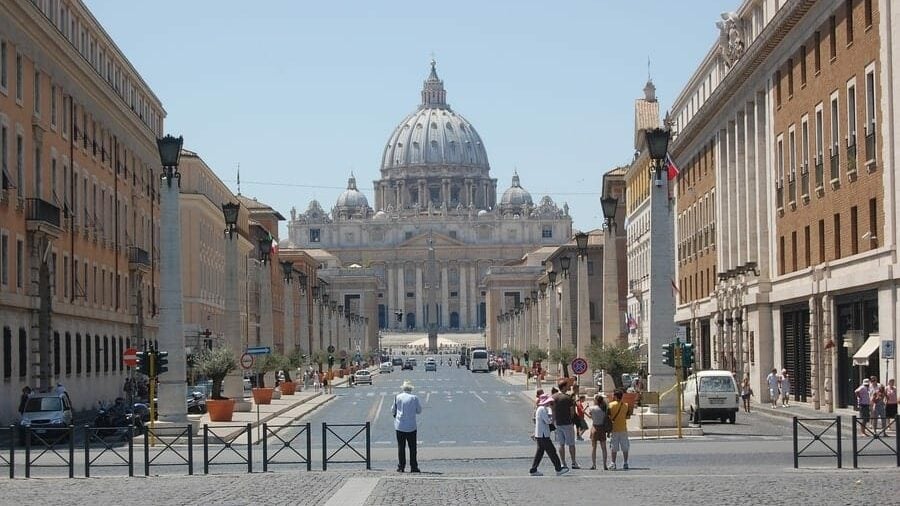
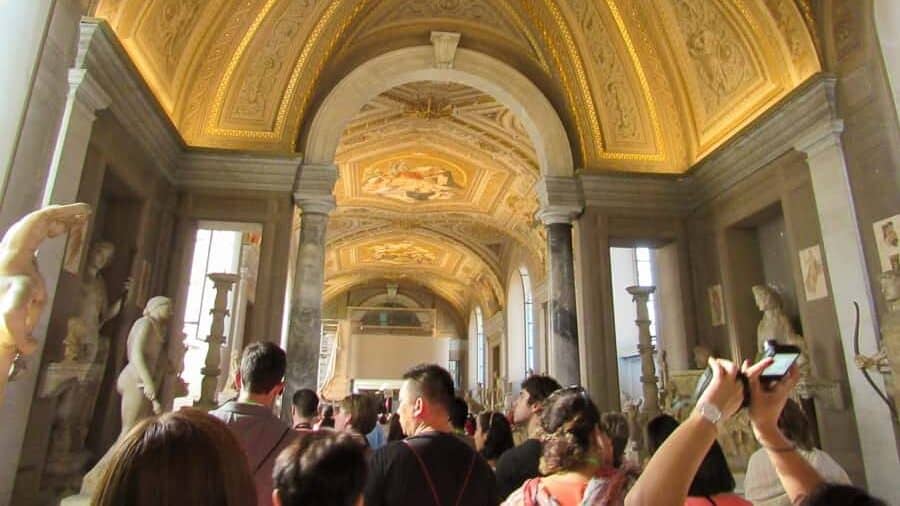
- Hours:
- Monday – Saturday: 8 AM – 8 PM; final entry 6 PM
- Sunday: 9 AM – 2 PM; final entry 12:30 PM
- Cost: € 20
- Buy your tickets in advance. There is a fast pass line (shamelessly, we didn’t do our research beforehand, which is why we were in line at 7:30 a.m.).
- Get there EARLY! They open early to the pre-ticketed holders. If you don’t get tickets ahead of time, just go first thing in the morning and prepare to wait for an hour in line. We can’t stress enough the need to get there early to beat the tour buses.
- The museum isn’t air-conditioned so depending on the time of year, it’s incredibly warm with the crowds of people hovering around.
- There is a STRICT dress code for the Cathedral. Ladies and gents, your shoulders and knees must be covered when inside of the Cathedral. Everywhere else on the property you should be fine to relax your dress a bit (especially if it’s sweltering hot outside).
The Vatican Museums house over 4 miles of art, ranging from classical sculptures to Renaissance paintings. They are home to the Sistine Chapel, Michelangelo’s iconic masterpiece painted between 1508–1512. The ceiling depicts biblical scenes, including the famous “Creation of Adam,” while The Last Judgment covers the altar wall.
We covered everything in under 2 hours, which felt very rushed. We highly suggest giving yourself a minimum of 3 hours. If you are following Rick Steves, his guide is around 2.5 hours.
Guided Tours: While Rick Steves’ free app provides a comprehensive audio guide, for a more in-depth experience, consider:
Remember when you get in the Sistine Chapel: keep quiet and no pictures whatsoever. The “friendly” employees will be sure to remind you if you forget aka you will be screamed it rudely.
St. Peter’s Basilica & Climbing the Dome

- Cost: €8+
- Entry: Look for signs for Cupola outside the Sistine Chapel
Let’s be honest, you probably aren’t looking for an intense climb in the middle of Rome, but if you are up for the challenge, climb the dome at St. Peter’s Basilica. It’s 100% worth it.
You can pay to walk up the first 231 steps to reach the initial level of the dome—or pay a few euros more to take the elevator. Trust us, take the elevator. It was 90 degrees the day we did it, and we definitely needed a shower afterwards.
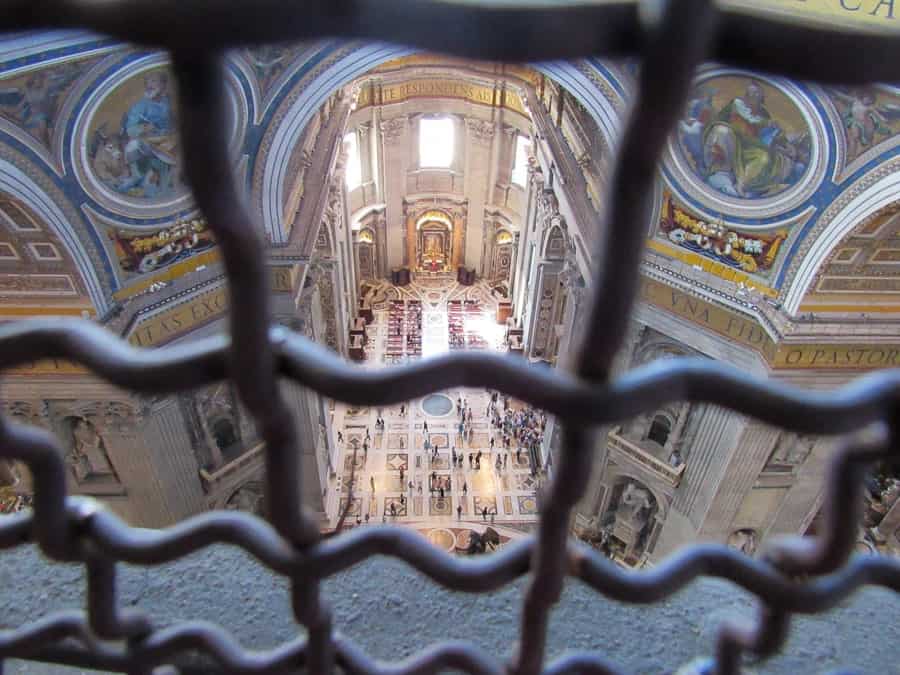
From the first level, you get a close-up view of the Apostles, a peek at the dome’s stunning interior, and a unique perspective looking down into St. Peter’s Basilica itself. Thought that was impressive? Just wait.
The second part of the climb is where adventure really kicks in. You’ll ascend an extra 330 steps to reach the tippity-top of the dome, or cupola, and get even closer to the sky.
If you’re claustrophobic, stopping at the first level is a good idea-the staircases get very narrow here, and you’ll share tight quarters with other climbers.
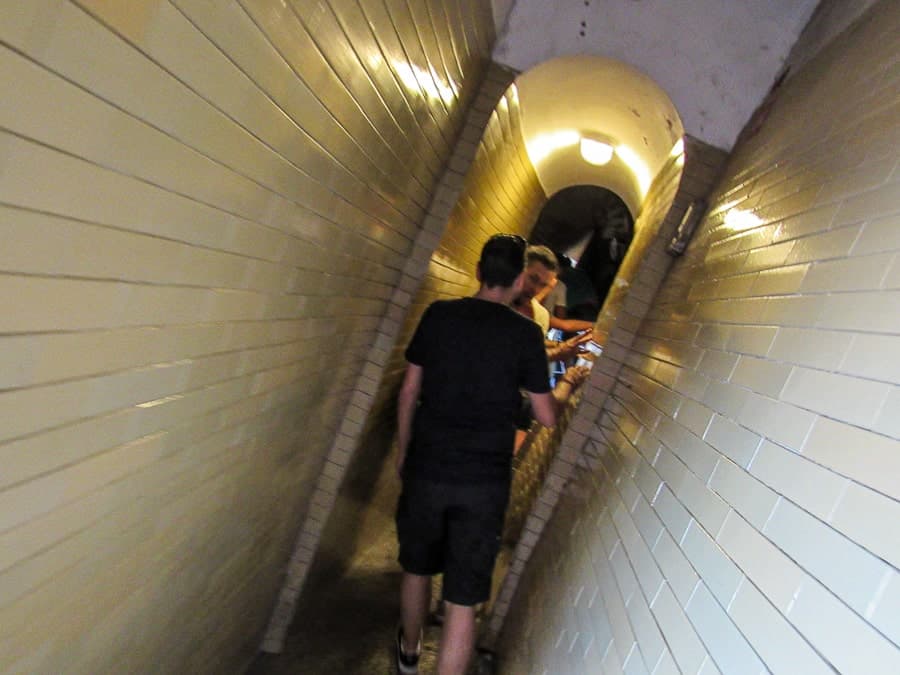
I (Sam) became very closely acquainted with the person in front of me when we paused on the stairs.
Expect it to be warm – there’s no air conditioning inside the dome. The route is full of slanted corridors, crooked stairways, and what might just be the world’s narrowest spiral staircase, complete with a rope handrail.
But the reward is absolutely worth it. Once you reach the top, you’re greeted with a breathtaking 360-degree view of Rome, spanning from St. Peter’s Square all the way to the Tiber River and beyond. Take a moment to catch your breath, soak in the views, and snap some unforgettable photos for your Rome itinerary.
And remember: what goes up must come down. The descent is just as much of an adventure, so take it slow and enjoy every step.
St. Peter’s Basilica

- Cost: Free
St. Peter’s Basilica is an architectural marvel, rebuilt in the 16th century atop the old Constantinian church. Michelangelo designed the dome, completed in 1590, which dominates Rome’s skyline.
Historical Context: The Basilica holds St. Peter’s tomb, and the altar of the Pope sits above it. Visiting here connects you to centuries of religious and cultural history.
We will say this again louder for those in the back: They are very strict about the dress code so please have shoulders and knees covered (both male and female).
This place was packed with people so prepare yourself. The best time to go is first thing in the morning or before they close at 7 PM (October-March it closes at 6 PM).
Lunch Options Near the Vatican
After exploring the Vatican Museums and climbing St. Peter’s Basilica, you’ll probably be ready for a break and a hearty lunch. Luckily, the area around Vatican City has some fantastic sandwich and panini spots that are perfect for refueling.
Mordi Sandwichouse®
Located just a short walk from St. Peter’s Square, Mordi Sandwichouse is a tiny but incredibly popular spot for traditional Roman panini. Prices are budget-friendly, ranging from €5–10, and the flavors are authentic. Think fresh mortadella, porchetta, and classic Italian cheeses, all served on freshly baked bread.
Pizza & Sandwich Da Pasquale
A short walk from the Vatican, Pizza & Sandwich Da Pasquale offers both pizza and freshly made sandwiches. With Google reviews hovering around 4.6 stars, this local favorite is known for its friendly service and generous portions. The sandwiches are simple, fresh, and perfectly suited to a busy day of sightseeing. This is a convenient and satisfying lunch stop.
Panino Divino
For a slightly more gourmet take, Panino Divino is another highly-rated spot near the Vatican (4.7 stars on Google). Run by a husband-and-wife team, it offers a selection of creative panini with high-quality meats, cheeses, and seasonal toppings.
We particularly appreciated the care put into each sandwich—something you notice when you’ve spent years tasting Italian panini like we have. Panino Divino is perfect if you want a quick but slightly elevated lunch without straying far from your Rome itinerary.
Spanish Steps (Piazza di Spagna)
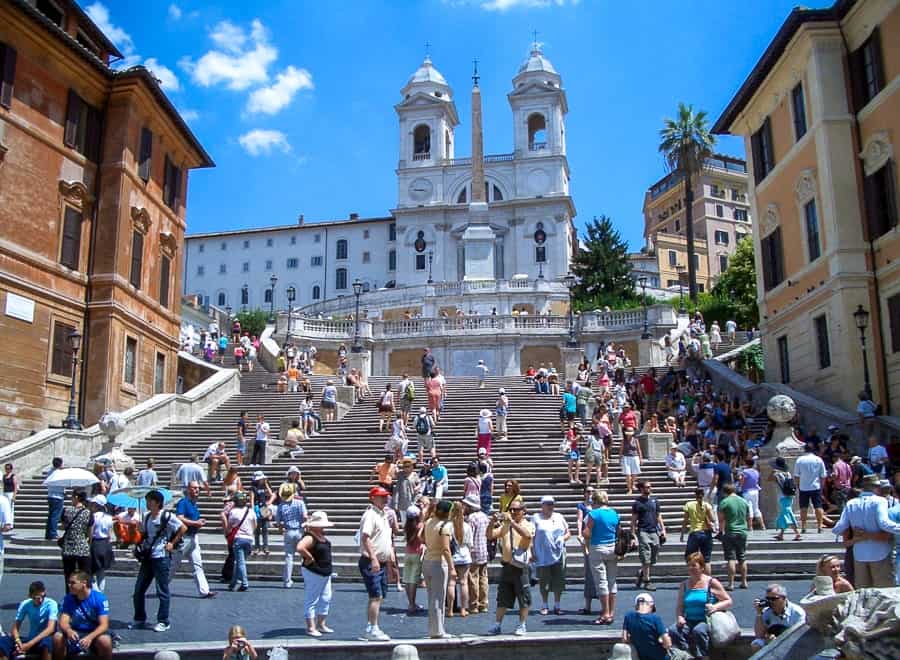
- Cost: Free (as long as you don’t sit, seriously)
The Spanish Steps are one of the most iconic landmarks in Rome and a must-see stop on any 3 days in Rome itinerary. Named after the Spanish Embassy, which has been located nearby for over 300 years, these steps have long been a gathering spot for both locals and tourists.
Historically, sitting on the steps was part of the Roman experience – people would relax, watch the city go by, and soak up the atmosphere. However, in August 2019, the city of Rome officially banned sitting on the steps.
Tourists caught lounging now face fines of €250, which can rise to €400+ if the steps are dirtied or damaged.
From our experience, police are generally lenient and often just ask you to stand (somewhat aggressively), but it’s best to follow the rules – especially when you’re trying to enjoy your 3 days in Rome stress-free.
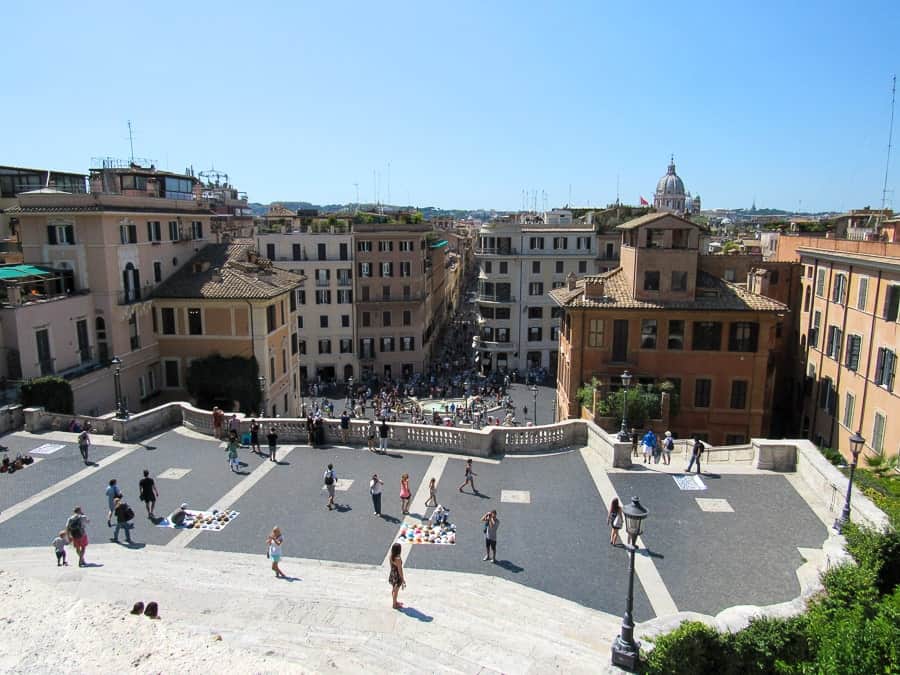
If you didn’t already climb the stairs at St. Peter’s Basilica (or where smart and took the elevator), the Spanish Steps are another opportunity to get some exercise – there are 138 steps to scale. Be prepared if you’re visiting during the summer, as there’s no shade and the sun can make the climb pretty toasty.
At the base of the steps, you’ll find the world’s largest McDonald’s, complete with over 400 seats, a salad bar, café, and dessert bar. We didn’t eat here, but we did pop in for a quick iced latte. It’s an interesting mix of modern convenience and historic surroundings.
For those who love designer shopping, the area around Via Condotti is prime territory. Here, you’ll find top international fashion brands lining the streets.
We enjoyed window shopping while sipping iced coffees – no need to break the bank if luxury isn’t your thing. Even a leisurely walk down the street provides a real sense of the elegance and style that permeates central Rome.
Pantheon

- Hours: Daily from 9 AM – 7 PM
- Cost: €5 per person
From the Spanish Steps, it’s just a 15-minute walk to the Pantheon, another must-visit Rome attraction. The Pantheon is a temple “to all the gods” (pan = all, theo = gods), built in 27 B.C. and later converted into a Catholic Church in 609 A.D. This conversion is what preserved the building so well- making it arguably the best-preserved monument in all of Rome.
The Pantheon’s dome is a marvel of Roman engineering. It features a nearly 8-meter-wide oculus, or central hole, which serves as the main source of light. Even rainwater is accounted for – the floor is cleverly slanted for drainage, showcasing the Romans’ genius problem-solving skills.
For perspective, this dome remained the largest in the world until the Renaissance and inspired iconic domes such as Florence Cathedral and St. Peter’s Basilica.
Inside, you’ll also find the tomb of Victor Emmanuel II, Italy’s first king, prominently displayed on the right-hand side. Walking through the Pantheon, you can really feel the layers of history-from ancient Roman worship to Renaissance architectural influence to modern Catholic use.
Fast Facts to Note:
- The U.S. Capitol Building in Washington, D.C., is inspired by the Pantheon’s dome.
- Michelangelo and Brunelleschi studied the Pantheon when planning their own domes in Italy.
- The building has been in continuous use for over 2,000 years, making it a living piece of history.
For a deeper understanding of this incredible landmark, we highly recommend using Rick Steves’ free audio guide. It walks you through the Pantheon and a few nearby churches, giving context to the history, art, and architecture that make this one of the top things to do in Rome.
Miscellanea
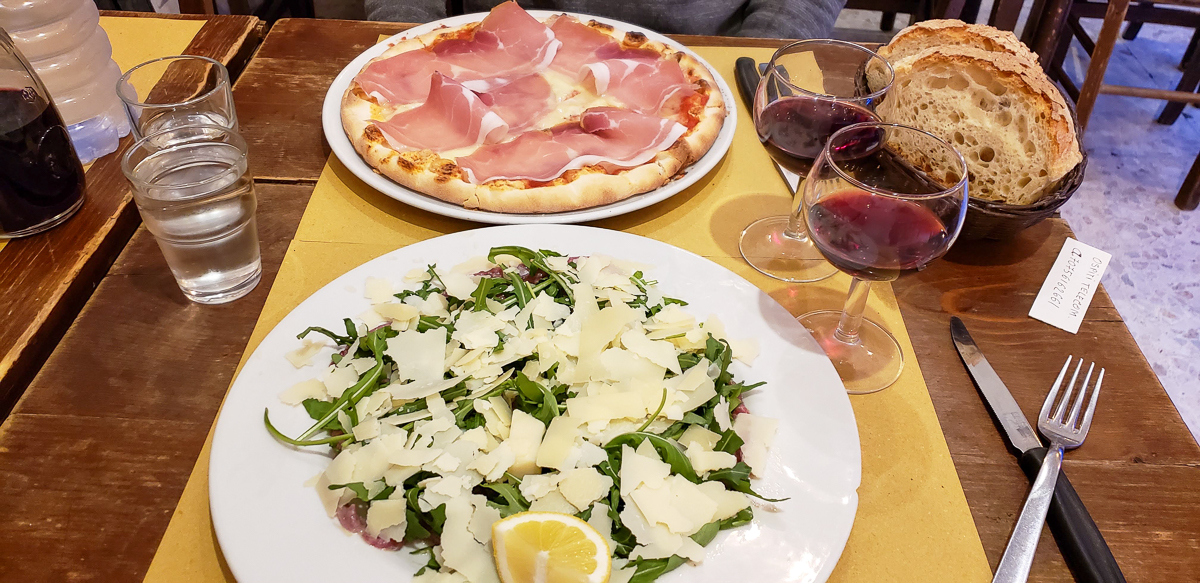
- Hours: Daily from 10 AM – 3 AM
- What to know before you go: This spot calls themselves “International Student Pub”
If you’re looking for a meal near the Pantheon that won’t break the bank, Miscellanea is a fantastic choice. This unassuming pub has a cozy, local feel and caters mostly to college students, which keeps prices reasonable without compromising quality.
We honestly walked past it several times before spotting it—it’s tucked between larger signs for Vineria Hosteria and easy to miss if you’re not paying attention. Once inside, we ordered a glass of wine, fresh bruschetta, and a pizza, all of which were delicious and satisfying after a morning of exploring Rome’s historic streets.
To our delight, at the end of the meal, they brought out a bowl full of fresh oranges for dessert—a simple but refreshing touch that felt authentically Roman. It’s the kind of spot we love to recommend to travelers on a 3 days in Rome itinerary because it’s authentic, budget-friendly, and just a short walk from the Pantheon, one of the city’s most famous landmarks.
Being honest, this meal isn’t something to write home about, but it was affordable and the staff was nice so we’ll take that as a win.
Pro Tip: This is a great place to take a break, recharge, and soak in some local ambiance before continuing on to your next Rome attractions, whether that’s Piazza Navona or exploring the surrounding historic streets.
Piazza Navona

Originally built as a stadium for athletic events, Piazza Navona is now one of Rome’s most vibrant squares. Lined with restaurants, cafes, and three large fountains, the piazza comes alive at night with street performers, live music, and bustling crowds. We loved grabbing a seat at a cafe, sipping wine, and soaking in the energy of Rome’s nightlife.
Day 3 in Rome: Villa Borghese and Travel Day
- Luggage Storage Termini Station
- Villa Borghese
- Convento dei Frati Cappuccini – Cappuccin Crypt
Luggage Storage – Termini Station
To make the most of your final day in Rome, especially if you have a later flight or train, we highly recommend using Radical Storage at Termini Station. We’ve used them ourselves while living in Italy, and it’s a game-changer for sightseeing without dragging your bags around the city.
Radical Storage allows you to drop off your luggage securely and explore Rome hands-free. The process is simple:
- Location: Inside or very near Termini Station, marked clearly for easy access.
- Hours: Radical Storage locations near Termini are open daily, typically from early morning until late evening, making it convenient no matter your schedule.
- Pricing: Starting at around €5 per bag for up to 24 hours. Prices are transparent, with no hidden fees, and you can book in advance online.
We love Radical Storage because it’s flexible – you can store backpacks, suitcases, or even larger trunks – and it’s fully insured. Once your luggage is safely stored, you can head off to explore without worrying about hauling heavy bags across cobblestone streets.
Booking ahead with Radical Storage also gives you peace of mind, especially during peak tourist season when lines at Termini can get long. Trust us, having a luggage-free day in Rome makes your last day infinitely more enjoyable.
Villa Borghese
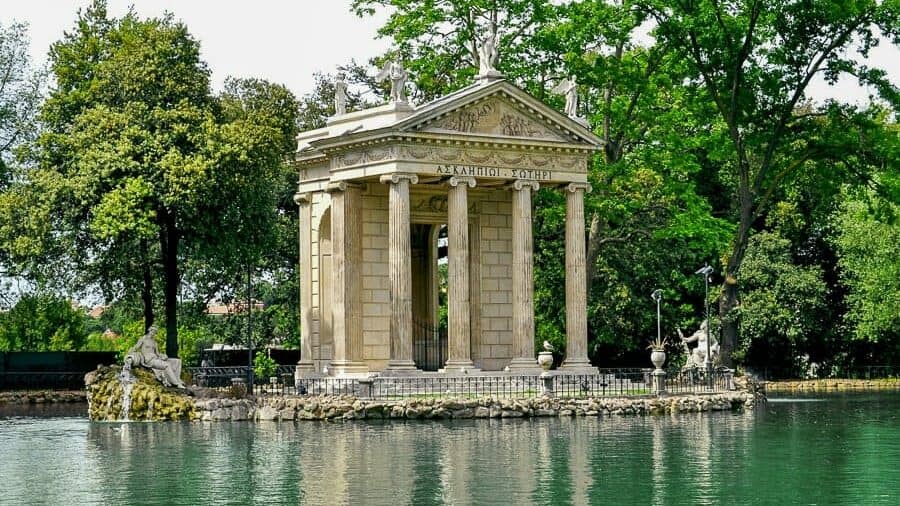

- Cost: Free
After dropping off our luggage at Termini, we made our way north to Villa Borghese, Rome’s answer to Central Park. It’s about a 20-minute walk from Termini via Vittorio Veneto, and the gardens are a welcome mix of shade, sunshine, fountains, and statues.
Villa Borghese spans 3 square miles and is perfect for a relaxed stroll, people-watching, or renting a bike to cruise through its scenic paths. From winding lanes and serene lakes to panoramic views over Piazza del Popolo, it’s easy to spend a couple of hours here soaking in the calm after two busy days of sightseeing.
You can also explore additional attractions inside the park, like Rome’s zoo (Bioparco di Roma) or cultural sites like the National Gallery of Modern Art, depending on your interests.
Borghese Gallery
- Cost: €15 + €2 booking fee
- Hours: Tuesday – Sunday: 9 AM – 7 PM (closed Mondays)
We’ll be honest, we opted not to go here, but have been informed that this is the most splendid art showing in Europe. The Borghese Gallery features masterpieces from Bernini, Caravaggio, and Raphael, among others, making it one of the most impressive art collections in Europe.
Even if art isn’t usually your thing (like us), the gallery’s opulent architecture and intricate sculptures are worth seeing.
Pro tip: Booking tickets in advance is highly recommended, as entrance slots are limited to maintain a comfortable flow inside the galleries.
Capuchins Crypt

- Cost: €10
- Hours: 9:30 AM – 1:30 PM & 2:30 PM – 6:30 PM
- Dress Code: Modest dress (no shoulders, no short-shorts)
- No photos or videos, phones must be on silent to enter
We decided to explore one of Rome’s more unusual attractions: the Convento dei Frati Cappuccini, home to the Capuchin Crypt. Located just a short walk from the Villa Borghese gardens, this crypt is unlike any museum or gallery you’ve ever visited.
The Capuchin Crypt is famous for its macabre decorations – over 4,000 human skeletons arranged in intricate patterns across six small chapels. While it might sound grim, the crypt was designed to remind visitors of the fleeting nature of life and the importance of spiritual reflection. Each chapel tells a story through its unique displays, from the bones of friars forming chandeliers to skulls arranged in geometric patterns.
We’ll let you research the details and save you the suspense, but the last room you walk into leaves you with a not so cryptic message “We were what you are….you will become what we are now.” Creepy!
Other Rome Attractions to see

Three days in Rome barely scratches the surface. If you have extra time, consider adding these highlights to your itinerary:
- National Museum of Rome
- Capitoline Museums
- Ara Pacis
- Catacombs
- St. Peter-in-Chains
- Trajan’s Column, Museum and Forum
- Castel Sant’Angelo
- Baths of Diocletian
Scams and Schemes
Gladiators at the Colosseum
As you approach the Colosseum, there are several very large, strapping men dressed in Gladiator outfits offering to take a photo with you. Remember that nothing in life comes free and they will ask you (more like hound you) for money. They can be rude and intimidating so be prepared to pay €5 for a photo.
Street Performers
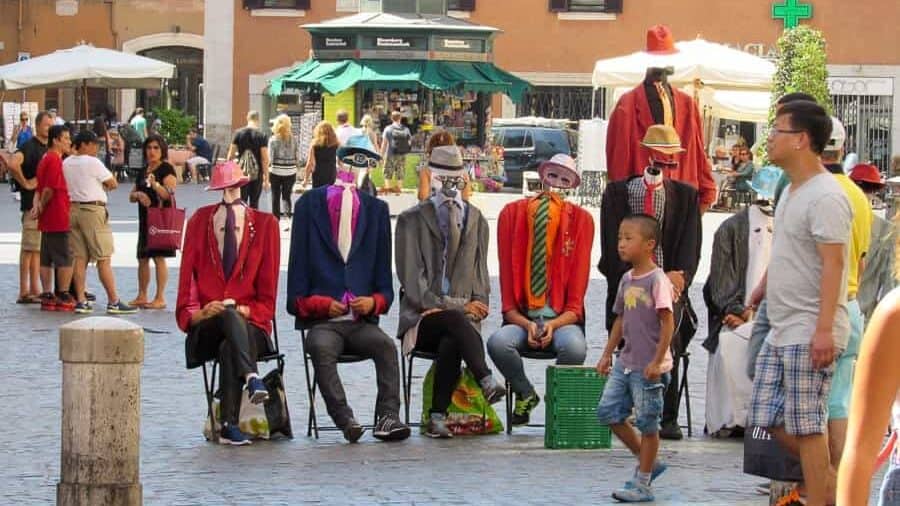
Similar to the gladiators, you will come across some really interesting street performers throughout Rome. There is a group of floating heads that roams around town and will have a member of their group (one of the non-floating heads people) chase down people who take a picture without paying. Luckily, I was far enough away to zoom in to snap this one.
Pickpockets
Like most big cities, pickpocketing can be a real issue on the crowded streets of Rome, especially around the big tourist attractions and on public transportation. There are too many types of pickpocket schemes to mention here (kids, roses, pretty women, injuries, etc.), but just trust your gut. If it seems like something is up, get out of the situation quickly.
Scheme at Termini Station
This happened to us (embarrassed, but now smarter). If you are using the automated machines to get tickets at Termini station, a person with a lanyard will be eager to assist you.
They are actually very helpful if you don’t know what you are looking for, but be prepared to give them money – they will demand it, and forcefully so. Yes, we were short on time since we spent too long at the crypts and wanted assistance so this was a good option for us.
They will help you buy your tickets and then walk you all the way to your train (they’ll often carry some of your luggage too) at the world’s fastest pace, so just be aware.
3 days in Rome is hardly enough time to scratch the surface of one of the oldest cities in Europe. From ancient monuments to bustling piazzas and delicious food, Rome is full of unforgettable experiences. We had an amazing time and can’t wait to go back and explore even more.
Looking for more Italy content? If you loved this 3-day Rome itinerary, you’re in luck – there’s so much more of Italy waiting to be explored! From hidden gems to local favorites, we’ve put together a collection of guides to help you plan your next Italian adventure.
- 3 Days in Naples, Italy
- A Weekend In Venice, Italy
- Ultimate Road Trip to Tuscany: A Wine Lover’s Paradise
Ready to visit Rome? Read hotel reviews and then book your room here!
But where do we personally recommend? Unico Argentine Suites is our hands-down favorite boutique hotel in the city. Their roof top bar has epic views too!
Don’t forget to pick up a travel guidebook for your other adventures.
Love this guide? Have questions? Get in touch with us on Facebook | YouTube | Instagram | Pinterest

